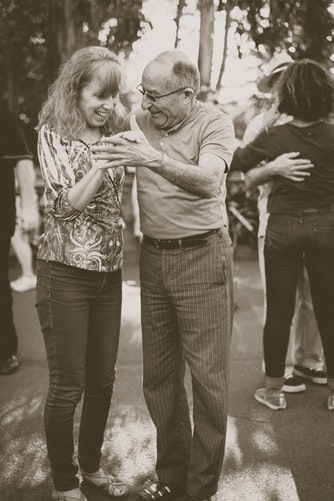Low-Impact Dancing 201

Welcome back! You’ve done all the prep work, and are ready to hit the dance floor. Time to dance your hardest and forget about your body, right? Uh uh, bad idea – in fact, this is where the MOST important part about dancing sustainably begins. If you want to still be dancing well into your senior years, keep reading.
You see, all that prep work from before – while very important – is basically just decreasing your chances for an injury. Next, you have to actually dance in a way that’s good for you. Fortunately, good ballroom technique and healthy dancing go (mostly) hand-in-hand.
The following three tips will increase your stamina, make you a more enjoyable partner, and yes, avoid the vast majority of injuries that can creep up on you.
Check your posture.
Problems with our posture and frame are the biggest factors leading to an injury. Why? Because when we hold ourselves in a sub-optimal way, we put pressure on joints and tendons, rather than the muscles they are designed for. Over time, those tendons will start to wear and tear, causing pain and reducing your mobility.
Here’s a few principles to remember:
- If you look at yourself sideways while in your ballroom frame, your wrists should be further forward than your elbows, which should be further forward than your shoulders. This prevents your arm joints from becoming strained.
- Make sure each block of weight: head, chest, hips, legs, and feet, are positioned above each other. A good way to check this is to stand with your back against a wall, touching it with as much of your body as possible.
- When moving, think of keeping your sternum over the balls of your feet, and the back of your head in line with your standing heel.
Practice smooth movements.
Want to take better care of yourself, AND your partner? Then learn to start sooner, and take longer. Many of us aren’t used to making gentle, careful movements, relying on the ‘big muscles’ to get us there. This creates spastic, jerky movement, which can cause us to pull something.
Instead, practice slower movements, and try to ‘fill the music’. If you stop moving, it means you finished that movement too soon – and that means you have more time to do it even slower. This shifts the energy from the big muscles to the stabilizer muscles, making them better able to protect you in all your activities.
Did I mention your partner will thank you as well? Slower, smoother movements mean a more comfortable dance, and reduces the chance that your partner will be caught off-guard by something unexpected. And a dancer that takes care of their partners, is a dancer who will have a lot of them!
Mind your energy levels.
Tempting as it may be to push yourself until you’re ready to drop from exhaustion, you also reduce your body’s ability to protect you when you push yourself to this extreme. Remember those stabilizer muscles? They won’t be able to protect you or your partner once they get tired.
Keep in mind that even the pros never burn every spare calorie out on the dance floor – not if they still want to be dancing in 10 years, that is. So always keep a small reserve, and be ready to call it quits when you feel yourself dipping into it.
About the Author
Ian Crewe has been dancing ballroom for over 18 years, and has a Licentiate in American smooth and rhythm. His passion for dance eventually led him to blogging and the World Wide Web. Ian currently teaches at the Joy of Dance Centre, Toronto, ON, Canada.

